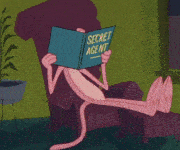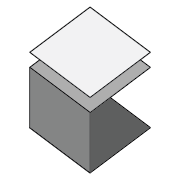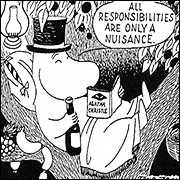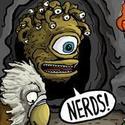|
It also turns out that Beeple and the guy who bought his artwork for $69 million are business partners. https://amycastor.com/2021/03/14/metakovan-the-mystery-beeple-art-buyer-and-his-nft-defi-scheme/
|
|
|
|

|
| # ? Apr 23, 2024 18:12 |
|
Well this whole ordeal has completely reversed the very high respect I had for Beeple. Jesus, lol
|
|
|
|
1) So all these other artists that I see in my feed going nuts over selling this piece or that piece for $300k, they have to actually convert that from ethereum to dollars (or whatever) in order to pay their rents, etc. Otherwise they're just holding cryptocurrency in a wallet, and if the value fluctuates their payday could be reduced or increased drastically, right? 2) If all these artists wanted to cash out, are there enough buyers of crypto that they reasonably could? Could Beeple actually convert his ethereum to millions tomorrow? Is the value of crypto affected by supply and demand forces, so that if tons of artists tried to cash in, the currency would depreciate?
|
|
|
|
Listerine posted:1) So all these other artists that I see in my feed going nuts over selling this piece or that piece for $300k, they have to actually convert that from ethereum to dollars (or whatever) in order to pay their rents, etc. Otherwise they're just holding cryptocurrency in a wallet, and if the value fluctuates their payday could be reduced or increased drastically, right? 1) Yes, and the IRS is very interested in any cryptocurrency transactions so they can make sure they're taxed appropriately. Also if you're sending or receiving a lot of money from a crypto exchange your bank may decide they aren't comfortable doing business with you any more. 2) It's absolutely affected by supply and demand, despite all the crypto bros talking about "market cap" it can be difficult to get money out since there's only a few legitimate (at least for the moment until they vanish) exchanges that will do crypto to dollars. That said, interest is up so there's more liquidity. Dumping it probably wouldn't lose you a ton of money although it would depend on what coin you were selling, how much, and where. There's threads for laughing at bitcoin in gibbis and yospos, although both have been haunted by bitcoiners throughout their stay so there's a lot of extremely bad posts throughout them. Divabot has written a couple of books about how bad crypto stuff is and he posts in them sometimes, though.
|
|
|
|
Taffer posted:Well this whole ordeal has completely reversed the very high respect I had for Beeple. Jesus, lol Yeah - pretty much this.
|
|
|
|
Just filed my taxes this year and noticed that they actually have a section for "cryptocurrency" now. The IRS is well aware, and they'll get theirs one way or another.
|
|
|
|
Taffer posted:Well this whole ordeal has completely reversed the very high respect I had for Beeple. Jesus, lol would it probably be more likely that beeple was just beeple and then someone befriended him with the promise of cash rather than he knew the dude since before he made millions of c4d dailies regardless he got rich from fiddling with buttons and we haven't. we're the suckers
|
|
|
|
echinopsis posted:
Psh You donít want 69million anyway Itís probably like... 30 after taxes... and all that lost online credibility... what a hassle 
|
|
|
|
Anyone here been responsible for leading/managing someone they hired this past year - going from a previous in-studio environment to introducing someone new to a full work from home setup? And on the other side - has anyone joined a new studio in a fully work from home setup after having previously been used to working in studios? we're going to have to do it soon and I'm curious if there's any insight people could share. From the person hiring/managing it would be good to know the kinds of hiccups you faced, and from anyone who started work in that kind of environment, what you felt could have been done better during the onboarding and how your workload was managed. My natural instinct is that it's going to be much more difficult to introduce people who have a freelance/solo heavy background - we have hired people in the past who exclusively work in-camera, dont use xrefs or layers, and do very little collaboration. organization for collaboration is always the biggest learning curve for someone who hasn't done it before and requires the most hands on in-person time, so that part kind of terrifies me.
|
|
|
|
cubicle gangster posted:Anyone here been responsible for leading/managing someone they hired this past year - going from a previous in-studio environment to introducing someone new to a full work from home setup? not in this particular industry but I can definitely recommend getting some software sorted out (not sure what the current standards are but i'm sure there's some good advice around) that let you share your screen while also being able to easily point and draw lines and whatnot -- it's a pretty good replacement for a lot of hands-on training. also partner work with side by side screen sharing or even just "watch me do stuff for a while and ask questions" would definitely help. hardest part is always learning the team's existing workflows and quirks regardless of wfh or in-office; so it's mostly just a logistics effort to try and provide ways to learn them, yeah
|
|
|
|
cubicle gangster posted:Anyone here been responsible for leading/managing someone they hired this past year - going from a previous in-studio environment to introducing someone new to a full work from home setup? I'm kind of in the middle of this. I was hiring an extra animator here when I got an offer from another company. I took the offer (I'm in MS and the company is in NC) and will be working remote for 3 months before moving. At the same time, hiring a support animator for my current job (ending on Apr 2) has turned into hiring my replacement. And some of those options are possibly remote. So - while I don't have any expertise in it this second. In the next few weeks I should probably have some good frying pan into the fire experience to share. edit; On a semi related note... goddamn Parsec is a great app. I had to go pick up my sick kid from school yesterday... took her home and just logged into my work machine and completed an edit. Like, actually did the edit not just "scraped by enough in Google Remote Desktop to export a file). Super loving impressed. BonoMan fucked around with this message at 18:19 on Mar 24, 2021 |
|
|
|
I started a new job in December that's a permanent remote position and it's been... interesting! I see everyone on a Google Meet call every morning for standup but otherwise most of my colleagues are just Slack avatars to me, and most people don't use avatars of themselves so it feels a bit weird. It seems much harder to just 'pick things up' remotely so I suggest having fairly thorough onboarding sessions and having people specifically available to answer questions. I was in the slightly awkward situation of there being a public holiday in the country where all our senior art team live in my first week, so for two days I was more or less entirely left to my own devices. If you have documentation for your toolchain and workflow, make sure it's up to date. And if you don't have documentation please write some up before your tech artist quits and nobody actually knows how to set things up or how they work, only that they do work, and then someone new starts and literally nobody knows how to get the tools set up and
|
|
|
|
I'm on the software rather than art side, but we do "pairing" which is super helpful. Basically it's just a video call with screen sharing, we use it both as a training tool and a troubleshooting tool. A more experienced dev can run through a workflow while the new hire watches and asks questions, then the new hire can repeat it and get input from the experienced dev, etc. Making sure there is no resistance to using this all the time is really important, because it's the only remote way to watch someone else work and see how they do things, and it's the most effective way to quickly get someone un-stuck from an issue. But training and fixing issues is the smallest challenge in a remote office, the biggest is making sure people can stay motivated (note this is NOT the same as making sure they're online and working for 8 hours) and reducing friction on close collaboration. That said I think you'll find it's not as difficult as it might seem at first, just set up some good collaboration/communication tools and processes to make sure communication never breaks down. Fwiw I have a CG background and have been a fully-remote dev for a little over 3 years.
|
|
|
|
Iím working from home now and one thing I struggle with is relaxing. I tend to add extra hours on top just so I donít seem lazy. Always feel like Iíve not done enough. A couple of people Iíve spoken to are the same. Guess itís mostly just anxiety about unstable jobs atm really.
|
|
|
|
yeah, ghost hours are a problem If I"m struggling with a task, I'll often put in an hour or 2 later in the evening, although I do try to make it up with longer dog walks 
|
|
|
|
studies show most salaried employees get 3 hours of work done in the average 8 hour day; pre-covid. it's fine. everyone's feeling it now that they're tracking their own time, but realise that it's totally normal and working too hard will destroy you
|
|
|
|
Jewel posted:studies show most salaried employees get 3 hours of work done in the average 8 hour day; pre-covid. it's fine. lol I want to see this study. was it souless government beurocratic jobs? I cant imagine anyone working in CG only putting in 3 solid hours of work each day. I think if you compare my best days to my worst, I've definitely got a full days worth of work done in about 3 hours once or twice because everything just clicked and fell together, but I wouldn't flip the comparison and say those other days I'm only getting 3 hours worth of work done. Really appreciate all the responses to my question. we've got a pretty rigid routine in place - a morning check in on video call at 10am to brief work and go over whats in the pipeline, then another optional call at 4pm which we'll have if we're closely collaborating and skip if everyones got a meaty amount of work to do. We use zoom for everything right now, and slack/google sheets for work reviews that need a little more documentation. We do need to create a workflow bible - how the server is organised, how we organise photoshop files, settings/elements we use, layers and general scene organisation/xrefs etc. That's probably going to take a while to put together and be a lot of work, but I imagine hiring someone without it would be a waste of everyones time. When we've hired in person, typically everyone that has been with us for a while will share the onboarding workload - one person will cover photoshop and sit with them for a few hours etc. I guess it feels odd to make it so formal - because now we need to block out a chunk of time and say 'youre doing photoshop while this new person watches your screen for 2 hours', even though it would always turn into 2hr sessions before. I have found that my days are so fragmented with phonecalls and emails, that sometimes it's better to just get stuff done around the house while keeping on top of things with work and set aside a solid uninterrupted 3-4 hours at the end of the work day when i get to open max and work with music. it's rare i get to divide it so cleanly though - usually what happens is I end up sat at my desk being interrupted constantly for 8 hours then having to do 3-4h of production at the end of the day anyway. cubicle gangster fucked around with this message at 21:34 on Mar 25, 2021 |
|
|
|
cubicle gangster posted:I have found that my days are so fragmented with phonecalls and emails, that sometimes it's better to just get stuff done around the house while keeping on top of things with work and set aside a solid uninterrupted 3-4 hours at the end of the work day when i get to open max and work with music. it's rare i get to divide it so cleanly though - usually what happens is I end up sat at my desk being interrupted constantly for 8 hours then having to do 3-4h of production at the end of the day anyway. I feel this one a lot. In my experience though it usually relates more to a growing company with more departments and levels of management rather than a remote thing, but I don't know your exact situation. But I've been going through the exact same thing with my work, tons of really small meetings and checkins and pairing sessions that it feels nearly impossible to actually get any of my own work done, because a 30 minute block of free time is definitely not near enough to get momentum in. My own working speed has suffered a lot, as well as my general motivation - that stuff is just exhausting. I don't solve this problem by working late though. I generally like the work I do but not so much that I'm going to let it consume my life - if my schedule is laid out in such a way that I have no blocks of time to get real work done... that's not my problem. It's an organizational issue that effects anyone with even the slightest amount of responsibility, and if they want me to have more time to focus on my own work then they'll make structural changes to actually resolve the issue. I'm not going to let organizational chaos give them tons of free work hours out of me. Definitely feeling the need to spend more time on personal projects to keep any skill from fading away though. COVID shutin mixed with exhausting work schedules really make it hard to find the motivation to actually get up and do it though.
|
|
|
|
I'm in a small studio with 6 of us full time and up to another 6 freelancers at any given time, I'm guessing the small size makes this stuff easier We switched over to WFH pretty seamlessly, largely due to to our pretty rigid pipeline and our TD guy writing some tools to streamline syncing files between home/office and scripts to sync our app versions/plugins/scripts remotely. We have drives mapped to home machines so we can swap scenes from home to office and no paths break. Some guys use a lot of remote desktop for comping and lighting, I mostly work locally cos you can't model poo poo over RD. We do everything over the free version of Slack and do our video chats over Jitsii, these aren't scheduled and not very common, mostly at the start of a new job to get the critical info to everyone We've had a few new people start as WFH, I haven't been involved in inducting them but most seem to have gone well. It helps when there's tools to ensure all files locations are on pipe and naming conventions are all locked in. Some of us are back in the office now a few days a week and it's fine, personally my work output is pretty much the same. The only thing that bothers me is I cant work naked in the office after my midday run, nothing like a good air-out when you're really sweaty I'm going to have a 3/2 home/office split in the future, I like it. EoinCannon fucked around with this message at 06:05 on Mar 26, 2021 |
|
|
|
Hi there. I'm hiring a 3D modeler over in SAMart right now. I figure this is the thread most likely to have interest in the work, so I'll post it here. If it feels like the post is vague and possibly missing important information, it's that I'm not a 3D dude and don't entirely know what to tell you I need. I'm hiring in good faith, though, and will give any extra info you need.  Character art references / tri-pose are available; I just have to send them directly and have been asked not to post them to the thread. Character art references / tri-pose are available; I just have to send them directly and have been asked not to post them to the thread.Thread link: https://forums.somethingawful.com/showthread.php?threadid=3963549
|
|
|
|
Sundae posted:Hi there. I'd say a suggestion is that while you don't wish to show the references you have for the character, it would be super helpful for interested people if you could find some references for what kind of style you're going for: Images of similar characters / the style used, images from games or anime/cg that's similar, so that any prospective modelers have a bit more of an idea of what you want going into it. Other VRChat avatars that the streamer likes and if they'd like something similar to them. Going by the Live2D -> VRChat mentions my first impression is that it might be a vtuber-esque anime character, for example, which might be entirely off the mark. Good on you for being upfront with a starting budget though, and I wish you luck in finding someone. ( Though, why not go to some of the VRChat modelers you mention in the post? )
|
|
|
|
SubNat posted:I'd say a suggestion is that while you don't wish to show the references you have for the character, it would be super helpful for interested people if you could find some references for what kind of style you're going for: Good idea. I'll provide an example in the other thread. The problem with going with the ones I know of is that the current vtuber craze has the talented modelers in the community completely overloaded with more commissions than they can handle. Like, "apply here for the lottery to see if you make my waitlist, maybe find out in two months" overloaded. (I'm not kidding, btw - I'm on someone's waitlist for the waitlist, which will be decided in ~2 months who gets into the next queue.) So, I'm spreading elsewhere a little since you never know who posts on SA.   This is the sort of style I'm talking. CG anime. The big thing is that it clearly looks like it's out of an anime even though it's 3D, and not a super-shiny 3D, poorly-textured interpretation of what was once anime, if that makes sense?
|
|
|
|
Sort of like the models in the new dragonball fighting games. Definitely 3d but cel shaded, almost.
|
|
|
|
I'm part of blender group focused on stylized shading/modeling, I could check if anyone there can do that type of work.
|
|
|
|
I'm dipping my toes into Blender for retopology, and I've been enjoying the modeling tools, but right now I can see the new mesh through the original model and it's making it difficult to see the surface I'm trying to work on. Is there any setting that will make the original model completely opaque, so when I rotate to a different part of the model I can't see the mesh of the new topology through the original?
|
|
|
|
I assume you mean "transparent" instead of "opaque"? The 'z' hotkey lets you switch between rendering modes, one of which puts everything into wireframe. There's probably also some way to make only specific objects render in wireframe, but I don't know it off the top of my head. You can also use 'h' to hide an object and alt-h to unhide all hidden objects.
|
|
|
|
In Solid view you can turn on backface culling in the viewport shading options, so you wouldn't see the parts of your retopology mesh that are facing away from you.
|
|
|
|
|
TooMuchAbstraction posted:I assume you mean "transparent" instead of "opaque"? The 'z' hotkey lets you switch between rendering modes, one of which puts everything into wireframe. There's probably also some way to make only specific objects render in wireframe, but I don't know it off the top of my head. No, I meant opaque. The green model is the new topology- you can see it through the original model which is in orange. I want the original model to be completely opaque, so that the parts of the new retopologized mesh that are on the far side of the original object are obscured and don't clutter the field. PublicOpinion posted:In Solid view you can turn on backface culling in the viewport shading options, so you wouldn't see the parts of your retopology mesh that are facing away from you. I have backface culling turned on, which is why the faces on the far side aren't appearing in that image, but the wireframe is still visible. I do not have wireframe checked in the object display properties. edit- I do have In Front selected, but I don't know why I'm still seeing the wireframe of the mesh when backface culling is on? Listerine fucked around with this message at 01:28 on Mar 31, 2021 |
|
|
|
As far as I can tell the wireframe is going to always show up in Edit mode, unfortunately. E: toggling "Show Overlays" will get rid of them, but also everything else. I can't find any specific option that will just do what you want. PublicOpinion fucked around with this message at 02:05 on Mar 31, 2021 |
|
|
|
|
Are you sure you didn't toggle something unintentionally? By default, the model you're working on isn't visible through other objects, even in edit mode. This is what it looks like for me: Edit: If you have "In Front" enabled in the object settings, it will ALWAYS be in front, no matter what anything else is set to. You should disable that if that isn't what you're looking for. Sailor Dave fucked around with this message at 02:33 on Mar 31, 2021 |
|
|
|
Sailor Dave posted:Are you sure you didn't toggle something unintentionally? By default, the model you're working on isn't visible through other objects, even in edit mode. This is what it looks like for me: I have no idea if I toggled something unintentionally, I followed a tutorial for the setup. I'd prefer to have In Front toggled because a lot of the mesh is clipping into the old model due to how low poly I'm building the retopo, so I won't be able to see large chunks of the retopo otherwise. I guess I just stumbled into a niche case that the right combination of settings is impossible.
|
|
|
|
If you're using the Shrinkwrap modifier, you can increase the offset while you're working to reduce the amount the high poly model would be clipping through.
|
|
|
|
|
I'm helping out on someone's film project and it's going to be rendered in unreal. I've never used it before, what bit of software do I need to bring in my asset and muck around with shaders and lights to output some rendered stills or turntables?
|
|
|
|
EoinCannon posted:I'm helping out on someone's film project and it's going to be rendered in unreal. I've never used it before, what bit of software do I need to bring in my asset and muck around with shaders and lights to output some rendered stills or turntables? What do you mean? For the in-unreal shaders, lights, renders etc all of that is handled in-unreal. Import models, import textures, set up shaders in-scene, set up a scene with a turntable/hdri lighting etc, render out. If you mean the workflow for getting things into UE, then it accepts FBX, GLTF, Alembic files, so any of the 3D programs can push things to it pretty easily. (And with datasmith you can have large referenced scenes that are easily updated from 3ds/revit/etc) You don't need a dedicated tool to import to it, it just gobbles up most common formats on it's own. If you mean ways to get materials with shaders into UE, then substance files autogenerate their slots, becoming a normal simple shader in-UE. If you lean on photoscanned assets Quixel bridge + mixer can set up all the shader stuff needed for their materials in-UE as well. (You should absolutely check out the free section on the marketplace https://www.unrealengine.com/marketplace/en-US/free?count=20&sortBy=effectiveDate&sortDir=DESC&start=0 to get some assets to get started, so you can see how others have done things, and use those shaders/materials as a kickoff point for learning them.) When you do renders in UE you pretty much just build the entire scene and import all the assets to be in-unreal, you don't use unreal like an offline renderer where it just grabs the data from your scene. Everything gets set up inside unreal. Sorry if it isn't entirely helpful, I'm not entirely sure what it was you were asking. So I got the impression you might have been looking at it the way you'd be looking at an offline renderer like V-ray 'ok, what program do I need to use to render in it?', which isn't really applicable. SubNat fucked around with this message at 13:08 on Mar 31, 2021 |
|
|
|
Also keep in mind Unreal is 100% open source and can be entirely modified from the ground up, and people even implement fully custom rendering pipelines if the default material system isn't enough for them, so theoretically a base unreal isn't always going to be the same as what you actually use -- I'd assume that's rarer in films however, hopefully. But it's still essentially a game engine at heart and you'll have to port things over appropriately. Definitely just download some samples, they offer a few short film samples like this: https://www.youtube.com/watch?v=3EJC1edU3Y4 What I'd recommend is trawling through the sample scenes and also these documentation pages to get some more technical info on what they're showcasing and how they're set up https://docs.unrealengine.com/en-US/Resources/Showcases/index.html Jewel fucked around with this message at 15:36 on Mar 31, 2021 |
|
|
|
Yeah I fully expect that if they were on a custom branch of unreal, they would have made that clear to Eoin, and supplied a compiled binary build if they knew what they were doing. But it's absolutely worth mentioning for the fringe case where they might be rolling say, one of the custom cel shading branches, etc. Also worth noting is that a lot of those showcases contain source assets as well as the in-unreal assets. Like with the Meerkat project; https://www.youtube.com/watch?v=03XMTFjZaUY If you browse through the project files they include the maya scenes with rigs + yeti groom setups, etc. In addition to the whole project you're already sitting on. There's a ton of valuable resources in both the marketplace and the learning tab in the launcher. There's also a bunch of useful resources on the forums, though they're unfortunately pretty difficult to find amongst the 99% white noise 'halp me' posts and threads. (But if you flip the forum to sort by most replies instead of newest, you can find some older+longer threads which have discussion about things like the lightmass system/how to improve render quality. Or get non-tiling shaders, etc etc.) Depending on how far along the project is, you should also see if you can get some pointers from the team as to how they're going to be handling the rendering/lighting. If scenes will be mostly baked lighting / hybrid, or if they'll be rolling with a fully realtime + raytraced setup etc. So that you don't for example spend a day getting into lightmass/baked lighting just to realize that the project will be mostly realtime + raytraced. Which of course depends a lot on what kind of scenes you'll have in the project. Doubly so when you'll presumably be learning primarily the things you need to help out, as opposed to getting a general understanding of everything.
|
|
|
|
Thanks for the info guys The project is super early in development, probably some way from production yet. If it ever gets there I'm doing some modeling and kind of want to try some things out with displacement and normals to see what I should be modeling and what I can do with maps Also just wanted to mess around with the materials and learn how it works as it's popping up more and more Sorry I didn't really word my question well, I wasn't sure if there was separate apps to do shaders and lighting but it looks like you just do it in unreal engine I'll just install it and start messing around
|
|
|
|
I might still be misunderstanding, but if the project uses a PBR workflow and you haven't done any realtime stuff before you might want to check out something like Substance Painter. (I think Quixel also has some equivalent tool but I don't know what it is). You can play around with normals and textures and stuff in there before bringing all your maps into Unreal. My understanding is they integrate pretty seamlessly. You can also do things like take one of your high poly sculpts and bake the detail to a normal map for a low poly model. Seems like that sort of thing might be up your alley.
|
|
|
|
500 posted:I might still be misunderstanding, but if the project uses a PBR workflow and you haven't done any realtime stuff before you might want to check out something like Substance Painter. (I think Quixel also has some equivalent tool but I don't know what it is). You can play around with normals and textures and stuff in there before bringing all your maps into Unreal. My understanding is they integrate pretty seamlessly. Thanks  I haven't really done much realtime stuff but have done a bit of normal baking with xnormal and ZBrush and I texture in Mari which is functionally similar to substance in that you can apply unreal shaders and plug in maps etc. This might be all academic now as it pertains to this project as there might be some Hollywood types and money getting involved, in which case an actual paid crew will get involved and I'll just pass over any crap I've made to them. I started messing around with unreal though and for shader lookdev it seems pretty much like using other physically based renderers like redshift or vray but with much more customisation, flexibility and optimisation to play with.
|
|
|
|

|
| # ? Apr 23, 2024 18:12 |
|
EoinCannon posted:Thanks Ah nice. Yeah I was worried my advice would be too beginner-ish. I've met some pro CG dudes in the past who had never used normal maps, though. I guess things have changed now that PBR is so ubiquitous.
|
|
|
































